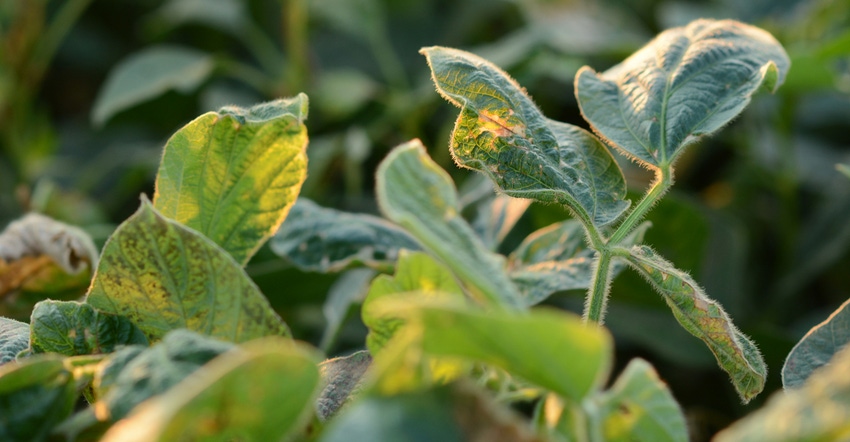
The Illinois Department of Agriculture has announced it will require additional restrictions on 2019 over-the-top dicamba use with a Special Local Needs label. That label imposes limitations beyond federal EPA restrictions, including a June 30 cutoff date.
“We want to do what we think is best and fair and still allow other producers out there to have the access to that product,” says John Sullivan, director of the Illinois Department of Agriculture, referencing exponentially higher numbers of dicamba herbicide complaints the past two years. “We’ve got to see those complaints come down. We have to.”
IDOA notified BASF, Bayer and DuPont/Corteva of the additional restrictions on Feb. 15. They include:
• a June 30 cutoff date for application of dicamba to dicamba-tolerant soybeans this year
• prohibited application when wind is blowing toward adjacent residential areas
• required consultation of the FieldWatch sensitive crop registry before application, plus compliance with all record-keeping label requirements
• maintain label-specified downwind buffer between last treated row and nearest downfield edge of Illinois Nature Preserves Commission sites
• recommend applying product when wind is blowing away from sensitive areas, which include but are not limited to bodies of water and nonresidential, uncultivated areas that may harbor sensitive plant species
IDOA says the intent is to reduce potential for off-target movement of dicamba formulations, including Engenia, XtendiMax, and FeXapan, and “thereby reduce potential for possible adverse impacts to dicamba-sensitive crops/areas.” The department received and investigated 330 dicamba-related complaints in 2018 and 246 in 2017. Dicamba was first licensed for over-the-top use in 2017.
“If we go into 2019 and see that number continue at that level, my concern is there will be an unbelievable amount of pressure to take that product [dicamba] off the market,” Sullivan says. “We don’t want that to happen. If those numbers don’t come down, we may all be sitting in front of a committee asking us to justify what we’re doing.”
Agronomist Karen Corrigan, McGillicuddy Corrigan Agronomics, says the cutoff date will help deter applications on double-crop soybeans, when temperatures are typically higher.
“That’s a positive. The rest will depend on Mother Nature. If she skips May like last year, it may not decrease the damage,” Corrigan says.
Retail reaction
Retail reaction to the additional restrictions has been positive.
“IFCA has supported a cutoff date for the past two years, so we applaud this move by the department, and we’re glad to be able to help provide input in this 24(c) label,” says Jean Payne, Illinois Fertilizer and Chemical Association. The Special Local Needs label that IDOA has enacted falls under Section 24(c) of the Federal Insecticide, Fungicide and Rodenticide Act (FIFRA), which states can use to pass more restrictive rules on federal pesticide labels.
For several years, Payne and her organization have proactively sought additional education and worked with farmers and retailers regarding the possible adverse impacts of dicamba use. A hard cutoff date makes it easier for retailers to stay in compliance.
“Even with the mandatory dicamba training, applicators were looking for more guidance on identifying sensitive areas, so these new labels also help better define sensitive areas and provide consistency among all three products to protect sensitive areas,” she says.
Payne says violating these new provisions of use in Illinois may be considered a “knowing” violation of the label, resulting in substantial monetary penalties or potential revocation of the applicator’s license. IFCA is advising its members to take the new label seriously.
Bayer’s Kyel Richard says many of Illinois’ label changes expand on language already included on the EPA label. “We’re pleased that Illinois growers will once again experience the weed control benefits of XtendiMax with VaporGrip Technology.”
Sullivan says IDOA considered both weather and calendar restrictions, but landed on a date restriction.
“Temperature would be one way to look at it, but trying to regulate and manage the temperature and the fluctuations in temperature and wind is just extremely difficult,” he says. “It’s not that it can’t be done, but it still would be difficult to regulate it.”
Sullivan says they also considered but ruled out a tiered cutoff date, given that temperature can fluctuate a great deal from north to south in Illinois on a given date.
“You have farmers and applicators that are across those lines, and can you really say, ‘On this side of that line, it’s this date, and on that side, it’s another date’?” Sullivan asks. “That presents its own problems.”
State lines
All eyes may be on Illinois for 2019.
“I’m told there are a number of states that are watching to see what Illinois does,” Sullivan says. “We’re a leader in corn and soybean production, so I think if we make a decision to do something, some of the other states would take heed and might follow suit. They may not, too.”
Illinois is the first state in the lower Midwest to enact an application cutoff date for 2019 on over-the-top use of dicamba. North and South Dakota have both filed for a June 30 cutoff as well, under the Special Needs Label; they had the same restriction in 2018. The Minnesota Department of Agriculture set a cutoff date of June 20, which follows its 2018 restrictions. As of press time, Missouri, Iowa and Indiana are all sticking with federal label guidelines, with no additional restrictions, though Indiana is changing its reporting strategies and looking closely at changes for 2020.
While Arkansas originally banned the use of dicamba from April 16 through Oct. 31, the state plant board last month decided to allow use through May 25. Additional restrictions impose a half-mile buffer around sensitive areas such as research stations, organic crops, specialty crops and non-dicamba-tolerant soybeans.
“The bottom line is that dicamba has been a very effective product, it has done a good job, and we don’t want to see it removed from the market,” Sullivan says. “We want it to be a tool they can use.
“If we have to take some steps and make some decisions that we know not everybody’s going to agree with, well, that’s part of being in a leadership position.”
About the Author(s)
You May Also Like






